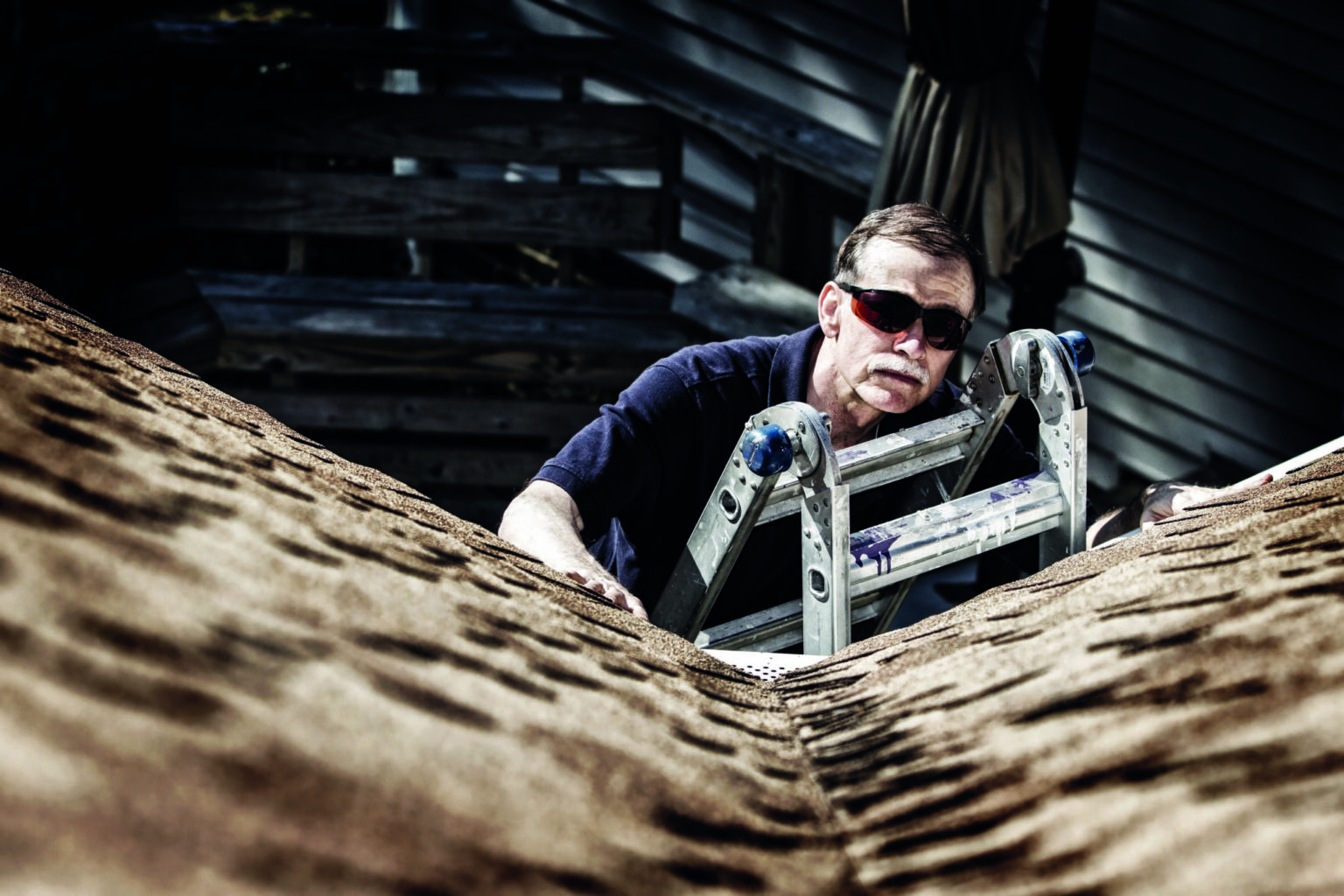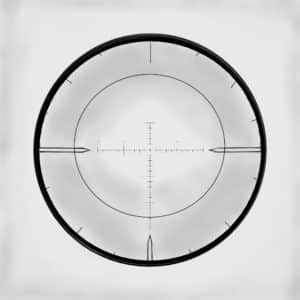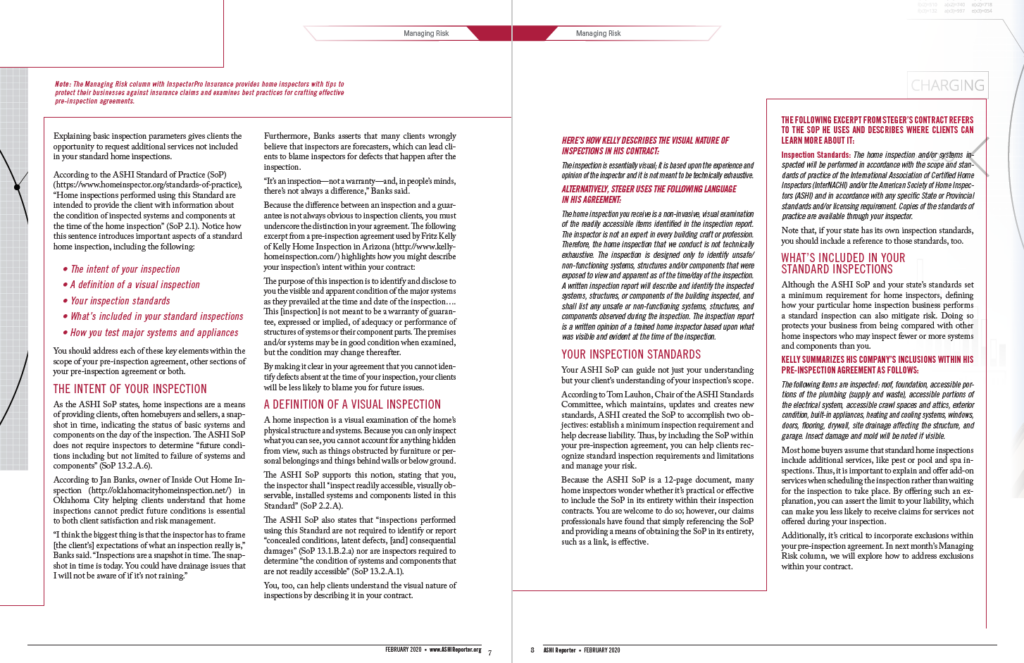Your Pre-Inspection Agreement: Scope
Last Updated November 22, 2023

 Your Inspection Scope
Your Inspection Scope
Merriam-Webster defines the term scope as an “intention” or “object,” meaning “the goal or end of an effort or activity.” One objective of your pre-inspection agreement is to define the scope, or purpose, of your inspection.
According to Matthew Steger of WIN Home Inspection in Pennsylvania, including the scope in your agreement can set reasonable expectations for clients.
“Most people have absolutely no idea what we do as far as a home inspection. They don’t know what’s included,” Steger said.
Explaining basic inspection limits also gives clients the opportunity to request additional services.
According to the ASHI Standard of Practice (SoP), “Home inspections performed using this Standard are intended to provide the client with information about the condition of inspected systems and components at the time of the home inspection.” (SoP 2.1) Notice how this sentence introduces important aspects of a standard home inspection, including the following:
- The intent of your inspection
- A definition of a visual inspection
- The inspection standards
- Your standard inspections
- How you test major systems and appliances
You should address each of these key elements within the scope of your pre-inspection agreement, other sections of your pre-inspection agreement, or both.
The Intent of Your Inspection
As the SoP states, an inspection provides clients a snapshot in time of a property. It indicates the status of basic systems and components on the inspection day. The ASHI SoP does not require inspectors to determine “future conditions including but not limited to failure of systems and components” (SoP 13.2.A.6).
According to Jan Banks from Inside Out Home Inspection in Oklahoma it's essential for clients to understand that inspections don't predict future conditions. Primarily, it helps with client satisfaction and risk management.
“The biggest thing is framing [the client’s] expectations of what an inspection is,” Banks said. “Inspections are a snapshot in time. The snapshot in time is today. You could have drainage issues that I will not be aware of if it’s not raining.”
Banks asserts many clients wrongly believe that inspectors are forecasters. Unfortunately, this can lead to blaming inspectors for defects surfacing after inspection inspection.
“It’s an inspection—not a warranty—and, in people’s minds, there’s not always a difference,” Banks said.
Explain the difference between an inspection and guarantee in scope of your agreement. The following excerpt, used by Fritz Kelly of Kelly Home Inspection in Arizona, highlights an inspection's intent:
The purpose of this inspection is to identify and disclose to you the visible and apparent condition of the major systems as they prevailed at the time and date of the inspection... This [inspection] is not meant to be a warranty of guarantee, expressed or implied, of adequacy or performance of structures of systems or their component parts. The premises and/or systems may be in good condition when examined, but the condition may change thereafter.
Make it clear that you cannot identify defects absent at the time of your inspection. This way, your clients will be less likely to blame you for future issues.
A Definition of a Visual Inspection
A home inspection is a visual examination of the home’s physical structure and systems. Because you can only inspect what you can see, you cannot inspect anything hidden from view. This includes things obstructed by furniture or personal belongings and things behind walls or below ground.
The SoP supports this, stating the inspector, shall “inspect readily accessible, visually observable, installed systems and components listed in this Standard” (SoP 2.2.A).
The SoP also states that “inspections performed using this Standard are not required to identify or report “concealed conditions, latent defects, [and] consequential damages” (SoP 13.1.B.2.a) nor are inspectors required to determine “the condition of systems and components that are not readily accessible” (SoP 13.2.A.1).
You help clients understand the visual nature of inspections by describing it in the scope of your pre-inspection agreement.
Here’s how Kelly describes it in his contract:
The inspection is essentially visual; it is based upon the experience and opinion of the inspector and it is not meant to be technically exhaustive.
Alternatively, Steger uses the following:
The home inspection you receive is a non-invasive, visual examination of the readily accessible items identified in the inspection report. The inspector is not an expert in every building craft or profession. Therefore, the home inspection that we conduct is not technically exhaustive. The inspection is designed only to identify unsafe/non-functioning systems, structures and/or components that were exposed to view and apparent as of the time/day of the inspection. A written inspection report will describe and identify the inspected systems, structures, or components of the building inspected, and shall list any unsafe or non-functioning systems, structures, and components observed during the inspection. The inspection report is a written opinion of a trained home inspector based upon what was visible and evident at the time of the inspection.
The Inspection Standards
By making these clear, you will not just help your understanding but your client’s understanding of your inspection’s scope.
According to Tom Lauhon, Chair of the ASHI Standards Committee, which maintains, updates, and creates new standards for the Association, ASHI created the SoP to accomplish two objectives: establish a minimum inspection requirement and help decrease liability. Including this SoP within your pre-inspection agreement can help clients recognize standard inspection requirements and limitations, managing your risk.
Because the ASHI SoP is a 12-page document, many wonder whether it’s practical to include the entire SoP within their contracts. You're welcome to do so; however, our claims professionals have found that simply referencing the SoP and providing a way to obtain the whole SoP, such as a link, is effective.
The following excerpt from Steger’s contract refers to the SoP he uses and describes where clients can learn more about it:
Inspection Standards: The home inspection and/or systems inspected will be performed in accordance with the scope and standards of practice of the International Association of Certified Home Inspectors (InterNACHI) and/or the American Society of Home Inspectors (ASHI)and in accordance with any specific State or Provincial standards and/or licensing requirement. Copies of the standards of practice are available through your inspector.
Note that, if your state has its own inspection standards, you should reference those standards, too.
What You Include in Your Standard Inspections
Although the ASHI SoP and your state’s standards set a minimum requirement, defining your business' standard inspections also mitigates risk. This prevents comparisons with other businesses that may inspect fewer or more systems and components than you.
Kelly summarizes his company’s inclusions as follows:

Most home buyers assume that standard home inspections include additional services, like pest or pool and spa inspections. Thus, it is important to explain and offer add-on services when scheduling the inspection. This is also preferable to just waiting for the inspection to take place. By offering an explanation in your agreement, you establish the limit to your liability. This makes you less likely to receive claims for services you don't offer.
Additionally, it’s critical to include exclusions within the scope of your pre-inspection agreement. In our next article, we will explore how to address exclusions within your contract.
How You Test Major Systems and Appliances
Testing procedures may vary across home inspection companies even more than inspection standards. It is not necessary to create a technically exhaustive description of your methods. But it is appropriate to underscore testing limitations.
The following are two common limitations you may address:
- Your home inspection will only cover a representative sample. That means you will not check every window, electrical outlet, switch, or fixture.
- Weather may inhibit your ability to inspect certain systems and structures, such as roofs, heating systems, and cooling systems. You will note any areas you were unable to inspect in your report.
There may be other testing methods you would like to have in your pre-inspection agreement to limit your liability. For example, Kelly references kitchen appliance testing restrictions, as noted in this excerpt from his contract:

By referencing simple limitations within your pre-inspection agreement, you help clients better understand basic constraints.
Make your pre-inspection agreement a priority.
Your inspection scope isn’t just an objective; it’s a risk management tool. Being your clients' main source for expectations ensures that they understand your services. Thus, they’re less likely to rely on information from another inspector or real estate professional offering different inspection types or inspecting under different standards. Setting these realistic expectations can help increase your clients' satisfaction and help you avoid claims.
You can prioritize your pre-inspection agreement. Have your clients sign it before every inspection. And make sure your contract is top-notch by using one of our state-specific agreements.
The ASHI Reporter published this article in February 2020. See how this story appears in print below.






